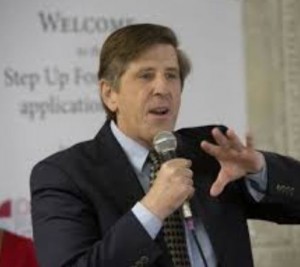
(Below is an edited version of a talk Step Up For Students President Doug Tuthill gave to the Florida Chamber of Commerce’s Prosperity Summit on May 3, 2018, in Orlando, Florida. The words have been modified slightly for length, clarity and focus. Step Up For Students also publishes redefinED.)
Let’s start with the good news. Public education in Florida has never been better. The most recent results from the Nation’s Report Card showed Florida students leading the country in Reading and Math gains.
Now the bad news. While Florida’s low-income students lead the nation in reading, only 30% are proficient. We look good because the rest of the country looks so bad.
We all understand the power of ownership. No one washes a rental car before returning it. Unfortunately, public education today turns too many adults and children into renters. We need to move from a system that disempowers and alienates too many adults and children, to one that empowers and engages them.
The Florida tax credit scholarship program our nonprofit helps run illustrates the importance of empowering families, students, and educators. We give scholarships to Florida’s lowest-income, lowest-performing children to attend a private school or a public school in another district. The scholarships are worth about 60 percent of what we spend to educate children in district schools, and yet we’re seeing good results.
Once on scholarship, these low-income students keep up with all students nationally on standardized test growth, and, if they are on scholarship for four or more years, they are 40 percent more likely to attend college. Choice leads to ownership and ownership produces better results. And in the case of our scholarship, better results for much less money.
There are several reasons why our public education system is so poorly designed, but two key historical reasons stand out. First is the hostility Protestants felt toward Catholics in the early days of the Republic. Second is the batch production revolution in manufacturing that occur in the late 1800s.
In the early 1800s, pluralism was the norm in public education. Control of public education was decentralized and schools were diverse. Rural schools were run informally by local communities. Urban schools were lightly regulated by city governments. Private secular and faith-based schools were often funded by local governments, and many families participated in what today we’d call homeschooling cooperatives.
This decentralized pluralism began to change with the influx of Catholic immigrants in the early-to-mid 1800s. Protestants controlled government and were convinced that Catholicism was contrary to democracy. They decided to use public education as a tool to diminish Catholicism.
The first mandatory school attendance law was passed in Massachusetts in 1852. Massachusetts was dealing with a huge influx of Catholic immigrants and state government’s goal was to use public schools to turn these immigrant Catholic children into good Protestants. Catholics responded by creating Catholic schools and the conflict between Protestant public schools and Catholic private schools was on.
In 1922, spurred on by Protestant nativist groups, including the KKK, Oregon passed a referendum mandating that all children attend Protestant public schools. An Order of Catholic Nuns called the Society of Sisters ran a Catholic school in Oregon. They sued. In 1925, the US Supreme Court overturned the Oregon law in Pierce v. Society of Sisters, granting children the constitutional right to attend a private school.
While this attempt to use district schools to eradicate Catholicism failed, a highly centralized, politically-controlled management system did emerge, as did a new definition of public education that excluded schools not owned and managed by school districts.
The emergence of batch production manufacturing in the late 1800s and early 1900s was the second major influence on how public education is organized and managed today.
Mandatory school attendance laws created a management challenge—how to efficiently educate all these children. Henry Ford and other industrialists were making manufacturing more effective and efficient through mass production assembly lines. Public school leaders decided to apply these same management systems to public schools by creating one-size-fits-all assembly lines that mass produced educated children by moving them annually from grade to grade in batches. Batch manufacturing became the norm in public schools.
While centralized decision making and batch manufacturing are efficient, they are not the most effective way to manage teachers or educate children. Teachers and students have an inherent need to be empowered and have ownership over their teaching and learning.
To be most effective and efficient, public education should be organized around empowerment, engagement, choice, and customization. We need to reduce the barriers that inhibit teachers from innovating and creating their own schools, and parents should be free to choose the schools that best meet their child’s needs. Customization should replace one-size-fits-all standardization, and parents should control their child’s public education funds so they can pay for customized education services from a variety of providers.
Today, 46 percent of Florida’s PreK-12 students—1.7 million—are participating in education choice and customization programs. We’re making progress, but equity is a challenge and many of these options are less effective than they should be.
As choice and customization in public education expand and evolve, we will continue to have robust debates about funding, accountability, curriculum, and instruction. But the best path forward is the one that aligns with human nature, embraces freedom and diversity, and works.


